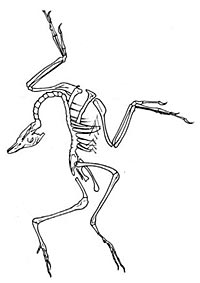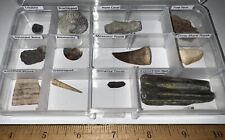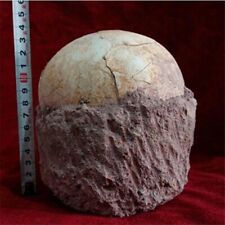
The peculiar pose – wide-open mouth, head thrown back and recurved tail – of many fossilized dinosaurs has led two University of California – Berkeley (UCB) paleontologists to challenge some long established theories about how these creatures died.
UCB’s Kevin Padian cites 150 million-year-old fossils ofArchaeopteryx (the earliest feathered dinosaur and the proposed link between dinosaurs and present-day birds) as an example of this common death pose. “Virtually all articulated specimens of Archaeopteryx are in this posture, exhibiting a classic pose of head thrown back, jaws open, back and tail reflexed backward and limbs contracted.”
Padian and veterinarian-turned-paleontologist Cynthia Faux , writing about their work in the journal Paleobiology, say that traditional explanations for the pose – that the creatures died in water and the currents drifted the bodies into that position, or that rigor mortis contorted the limbs – don’t ring true. “I’m reading this in the literature and thinking, ‘This doesn’t make any sense to me as a veterinarian’,” said Faux. “Paleontologists aren’t around sick and dying animals the way a veterinarian is, where you see this posture all the time in disease processes, in strychnine cases, in animals hit by a car or in some sort of extremis.”
“This puts a whole new light on the mode of death of these animals, and interpretation of the places they died in,” Padian explained. “This explanation gives us clues to interpreting a great many fossil horizons we didn’t understand before and tells us something dinosaurs experienced while dying, not after dying.”
Interestingly, because the posture has been seen only in dinosaurs, pterosaurs and mammals, which are known or suspected to have had high metabolic rates, it appears to be a good indicator that the animal was warm blooded. Animals with lower metabolic rates, such as crocodiles and lizards, use less oxygen and so might have been less traumatically affected by hypoxia during death throes, say the researchers.
By studying a large number of fossil skeletons, Padian and Faux were able to distinguish animals that underwent post-mortem water transport from those with the classic “dead-bird” posture, which they interpret to be the result of biological processes. Faux, using her experience as a veterinarian, discounted rigor mortis as the cause by obtaining badly injured birds that had been euthanized at a raptor recovery center and watched them for movement during the process. “They weren’t moving. They were staying in whatever position I’d left them in. I thought, ‘If birds aren’t doing it, and I’d never observed a horse doing it, then why would dinosaurs be doing it’,” she said.
The only explanation that makes sense, they concluded, is central nervous system damage. The cerebellum is responsible for fine muscle movement and once the cerebellum ceases to modulate the behavior of the muscles, the muscles pull at full force, tipping the head and tail back, contracting the limbs and opening the mouth, they write.
Reanalysis of many fossil finds should be considered say the authors, citing the mass death uncovered in Nebraska in the early 20th century. They argue that cerebellar dysfunction explains the opisthotonic posture of the numerous camel-like fossils better than does the common explanation – that the animals died in a stream and were washed into an eddy or backwater. This example and others; “suggest that reevaluation may be in order for an untold number of paleoenvironments whose story has been at least partly explained on the basis of the death positions of many of their fossil vertebrates,” the authors conclude.
Related articles:
Oxygen Increase Behind Rise Of Mammals
Geologists Hope To Disprove Asteroid Mass Extinction Scenario
Smoking Gun For Permian-Triassic Extinction Found
Different Dinosaur Death Theory Erupts


















Comments are closed.